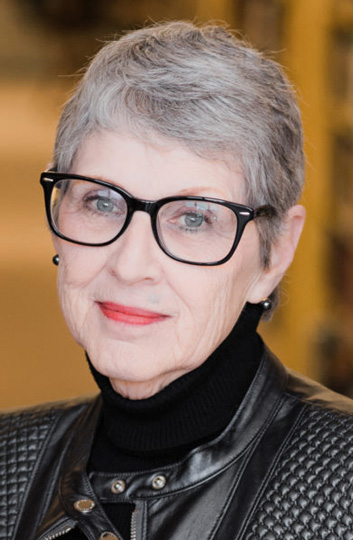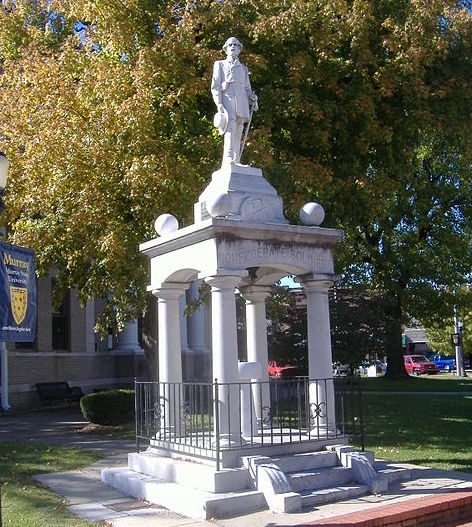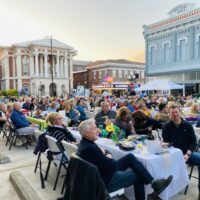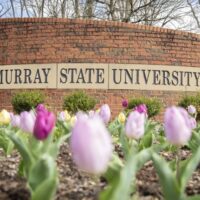Boxing Day in Murray was a quiet affair. At 10 a.m. the day after Christmas, the town may have gotten up early but is still shuffling around in its slippers. The courthouse is closed, as are many of the businesses. In homes around the county, families are picking up the debris from yesterday, sorting through who gave what to whom, figuring out meals for the rest of the weekend, throwing in another load of wash. Even without company, there are details to attend to.

Downtown, two opposing groups are settling into their places near the corner of Fourth and Main, strategically positioned by the statue of a Confederate soldier (alias Robert E. Lee) that has stood on courthouse grounds for more than a hundred years.
The three women who have showed up in support of moving the monument share a single vision. Robyn Pizzo explains that she wants to emphasize that the Move the Monument group is composed of more than university students, and that removal efforts do not stop when the semester is over.
“It’s important to see that it’s a community movement,” she said.
Another #RemoveRobert devotee, Christine Lindner, emphasized that the concept of relocating the statue is not seasonal or a one-off idea, and that a regular Saturday morning schedule of showing up with signs helps the movement gain traction.
“We are a reminder that we’re still here,” Emily Evans remarked. “Even the cold won’t keep us away.”
About 10 feet from them, Russell Sledd stands in opposition. “Keep the statue,” one of his placards reads. Another one says, “Leave our monument.”
When asked to whom “our” refers, Mr. Sledd said, “It means our community. There’s history on both sides. It’s all according to how you interpret it.”
He summarized the schism as the “northern philosophy” vs. the “southern philosophy.”
Throughout our give-and-take, Sledd and I try to find common ground. The encounter is even-tempered and respectful, but we totally disagree. He believes, for instance, that slavery was not the cause of the Civil War.

“States rights” he insists.
He also asserts that there have never been racial problems in Murray until an “outsider” came in to roil things up. And he wonders why white people are demonstrating and asks where are the local Blacks who want it removed.
He tells a tale of Martin Luther King visiting Paducah in the 1960s and swears that when Blacks in Murray were asked if they wanted Dr King to make a stop in Calloway County, they said no.
“We’ve never had a racial problem in our town,” according to Sledd.
When he refers to Public Law 85-425, passed by Congress in 1958, I make a note to research the information as Sledd pulls out his phone to show me an internet site.
“Just for the record,” it proclaims, “Confederate soldiers, sailors, and marines in the Civil War were made U.S. veterans by an act of Congress in 1957.”
The citation also mentions legislation passed in 1929, Public Law 810, that supposedly directed the war department to erect headstones and recognize Confederate grave sites as U.S. gravesites.
When I get home and research both laws, I discover there are indeed public laws with those numerical designations, and that they were enacted on the dates cited. It doesn’t take much digging, however, to find out that the interpretations Sledd expressed about the laws are not accurate.
The 1958 law is about increasing monthly pension rates “payable to widows and former widows of deceased veterans of the Spanish-American War, Civil War, Indian War, and Mexican War, and provide pensions to widows of veterans who served in the military or naval forces of the Confederate States of America during the Civil War.”
Nowhere does the law state that Confederate veterans have been legally designated as veterans of the U.S. military.
The 1929 law authorized the marking of unmarked graves of Confederate service members outside V.A. national cemeteries but did not confer U.S. veteran status to those affected.
Further documentation refers to the 1868 pardon granted to Confederate soldiers by President Andrew Johnson, but the pardon does not confer U.S. veteran status on Confederate military.
So the argument that Robert E. Lee and others who fought for the Confederacy were somehow officially designated as U.S. veterans is just not true and should not be used to justify the memorial staying in place. Nevertheless, I’m guessing monument supporters would insist that somehow the legal words on the page do not mean what they say.
When Sledd proclaimed, “We cannot live in the past,” I don’t disagree, but when he declared that “A monument is a monument; nothing on it says about hate,” I object.
“I don’t understand what all the problem is,” he said at one point about Blacks in general. “They get their own channel on TV.”
“Is it possible to get people to agree about removing the statue?” I ask him.
“I don’t think so,” he replies. “We have to go about our daily life and try to improve ourselves. There are so many pressing things in our lives.”
On the other hand, with Calloway County’s bicentennial coming up in 2022, isn’t it about time we seized the opportunity to remove a symbol of racial oppression from its place of honor in our town?
For accurate information about Public Law 85-425 and Public Law 810, go to uscode.house.gov and www.snopes.com.
(Constance Alexander is a columnist, award-winning poet and playwright, and president of INTEXCommunications in Murray. She is a board member for Hoptown Chronicle. This column first ran on www.kyforward.com Reach Alexander at calexander9@murraystate.edu. Or visit www.constancealexander.com.)



